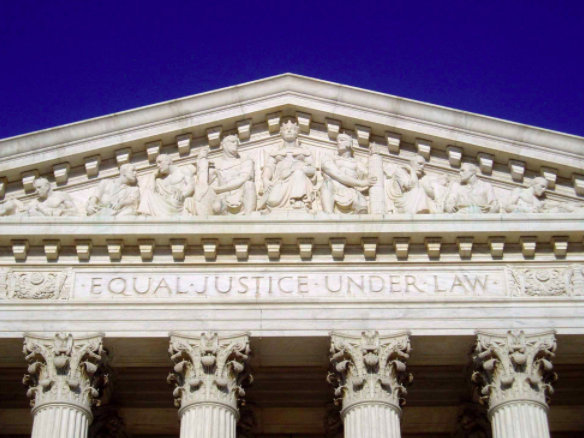Travel Ban Update: Without Addressing the Merits, the Supreme Court Stays Injunction Pending Further Proceedings
On Monday, the Supreme Court issued a stay of the Maryland federal district court’s injunction against the Sept. 24 immigration order (EO-3) in International Refugee Assistance Program v. Trump and an the identical stay of the injunction in Hawaii v. Trump. Justices Ruth Bader Ginsburg and Sonia Sotomayor would have denied the government’s request for a stay.

Published by The Lawfare Institute
in Cooperation With

On Monday, the Supreme Court issued a stay of the Maryland federal district court’s injunction against the Sept. 24 immigration order (EO-3) in International Refugee Assistance Program v. Trump and an the identical stay of the injunction in Hawaii v. Trump. Justices Ruth Bader Ginsburg and Sonia Sotomayor would have denied the government’s request for a stay. The court’s order allows the latest iteration of the travel ban to go into effect, pending further proceedings in the courts of appeals and, if relevant, the Supreme Court. However, this latest stay signifies little or nothing regarding the court’s view of the merits in the challenges to EO-3.
Background on the September Order
In marked contrast to the temporary nature of earlier iterations of the travel ban, EO-3 indefinitely suspends entry of both immigrants and some or all classes of nonimmigrants from Chad, Iran, Libya, North Korea, Syria and Yemen (see my earlier post). In addition, the new ban bars entry of immigrants from Somalia, subjects Iraqi nationals to heightened screening, and bars certain Venezuelan government officials from entering as nonimmigrants.
EO-3’s indefinite ban effectively reprises the national-origin quota system that Congress decisively rejected in the landmark 1965 Immigration and Nationality Act (INA) amendments of 1965. In the groundbreaking 1965 legislation, Congress sought to ease the pain of separation for close family members separated from U.S. citizens and legal permanent residents (LPR) by national borders. (See pp. 297-98 of Jack Chin’s excellent article.) In contrast, EO-3 indefinitely prolongs that separation for nationals of the listed countries. EO-3 targets countries in the Middle East and Africa (North Korea is a red herring in EO-3, since its nationals aren’t free to leave, and EO-3 only affects a few Venezuelans related to government officials there). Singling out the listed countries echoes the Asia-Pacific triangle quota that the 1965 legislation rejected.
Congress acted belatedly in 1965, after receiving a warning in 1957 from President Eisenhower that the quota system “operate[d] inequitably” and a further admonition from Eisenhower in 1960 that “[i]n the world of today [the quota system] … badly needs revision.” As argued in an amicus curiae brief filed in the Fourth Circuit and Ninth Circuits for immigration law scholars by me and counsel of record Alan Schoenfeld of Wilmer Hale, Eisenhower’s warning joined similar statements from presidents Truman (the quota system infringed on “our national ideals”), Kennedy (quotas were “without basis in either logic or reason”), and Johnson (declaring to Congress through Secretary of State Dean Rusk that the unfairness and arbitrariness of quotas adversely affected the United States’ “influence” overseas). Since Congress in 1965 took these warnings to heart and abolished quotas, our brief argues that EO-3’s backdoor reprise of the discredited quota system is inconsistent with the INA’s structure and logic. It is also inconsistent with the antidiscrimination provision, 8 U.S.C. § 1152(a)(1)(A), that Congress added in 1965 to limit executive discretion. (For further discussion, see my analysis of the travel ban at pp. 36-49.)
The Supreme Court’s Monday order does not telegraph a view of the merits of the case, but instead stems from precedent regarding provisional relief. Under Nken v. Holder (2009), the court’s issuance of a stay entails sliding-scale consideration of the likelihood of prevailing on the merits, irreparable harm and the balance of equities. Both the Fourth and Ninth Circuits will hear arguments on the travel ban this week. In urging that the Fourth and Ninth Circuits decide these cases with “appropriate dispatch,” the court’s stay addresses the irreparable harm prong of the stay test.
Balancing the equities, the court may have realized the following: The pre-stay relief imposed in both the Fourth and Ninth Circuits echoed the Supreme Court’s Solomonic test from its summer stay of relief regarding EO-2’s temporary ban. That stay exempted from the ban’s operation foreign nationals with a “bona fide relationship” with U.S. persons. Last summer, the court interpreted that test as including those with an offer of employment or a speaking engagement in the U.S., along with a range of relatives, from spouses and children to grandparents and cousins. However, EO-3 largely blocks family- and employment-based immigration from the listed countries. Under the court’s “bona fide relationship” test, virtually all family- or employment-based immigrants would have qualified for relief. Under the circumstances, applying that test would have enjoined virtually all of EO-3 pending resolution of the merits. To avoid that imbalance, the court allowed EO-3 to go into effect pending further proceedings. The court may have also decided to give the government the benefit of the doubt on the merits at the stay stage, as it often has in the past.
Given the strength of these stay factors, there is no reason to think that a majority of the court reached the merits. That crucial adjudication will occur first in the Fourth and Ninth Circuits and then quite possibly in the Supreme Court by early 2018.



.jpg?sfvrsn=676ddf0d_7)

